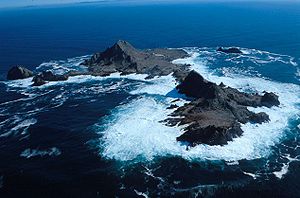Farallon Island
| Farallon National Wildlife Refuge | |
|---|---|
|
IUCN category IV (habitat/species management area)
|
|

Southeast Farallon Islands from the west, with Maintop Island in the foreground (right)
|
|
 |
|
| Location | Pacific Ocean |
| Nearest city | San Francisco, California, United States |
| Coordinates | 37°43′30″N 123°01′49″W / 37.7249303°N 123.0302779°WCoordinates: 37°43′30″N 123°01′49″W / 37.7249303°N 123.0302779°W |
| Area | 41.9 acres (17.0 ha) |
| Established | 1969 |
| Governing body | United States Fish and Wildlife Service |
| Website | Farallon National Wildlife Refuge |
|
Farallone Islands
|
|
| Area | 211 acres (85.4 ha) |
| Built | 1539 |
| NRHP Reference # | 77000332 |
| Added to NRHP | March 08, 1977 |
The Farallon Islands, or Farallones (from the Spanish farallón meaning "pillar" or "sea cliff"), are a group of islands and sea stacks in the Gulf of the Farallones, off the coast of San Francisco, California, United States. The islands are also sometimes referred to by mariners as the "Devil's Teeth Islands," in reference to the many treacherous underwater shoals in their vicinity. The islands lie 30 miles (48 km) outside the Golden Gate and 20 miles (32 km) south of Point Reyes, and are visible from the mainland on clear days. The islands are officially part of the City and County of San Francisco. The only inhabited portion of the islands is on Southeast Farallon Island (SEFI), where researchers from Point Blue Conservation Science and the U.S. Fish and Wildlife Service stay. The islands are closed to the public.
The Farallon National Wildlife Refuge is one of 63 National Wildlife Refuges that have congressionally designated wilderness status. In 1974 the Farallon Wilderness was established (Public Law 93-550) and includes all islands except the Southeast Island for a total of 141 acres (57 ha).
The islands were long known by the name "Islands of the Dead" to the American Indians who lived in the Bay Area prior to the arrival of Europeans, but they are not thought to have traveled to them, either for practical reasons (the voyage and landing would be difficult and dangerous) or because of superstition (the islands were believed to be an abode of the spirits of the dead).
The first Europeans to see these islands were most probably the members of the Juan Cabrillo expedition of 1542 which sailed as far north as Point Reyes, however no source record of the Cabrillo expedition's actual sighting of these islands has survived. The first European to create a record of the islands which has survived was the English privateer and explorer Sir Francis Drake, on July 24, 1579. On that day, Drake landed on the islands in order to collect seal meat and bird eggs for his ship. He named them the Islands of Saint James because the day after his arrival was the feast day of St James the Great. The name of St James is now applied to only one of the rocky islets of the North Farallones.
...
Wikipedia
